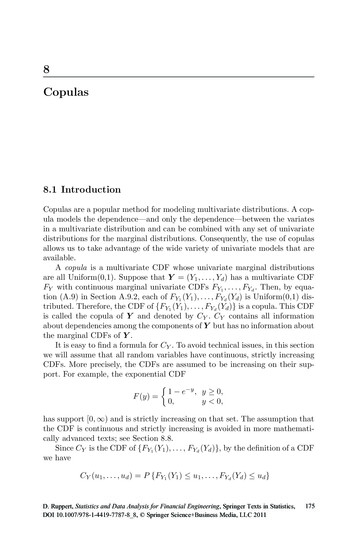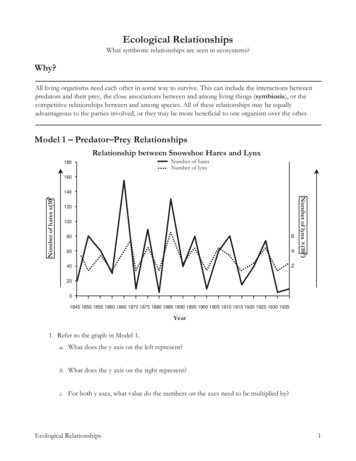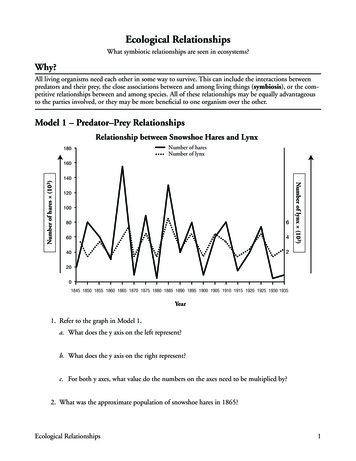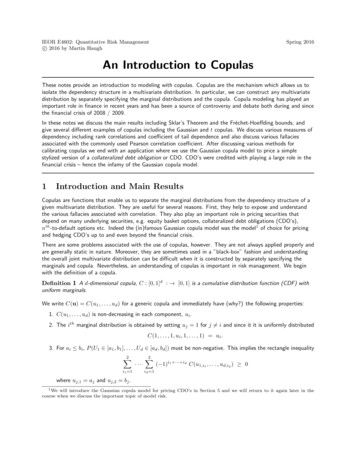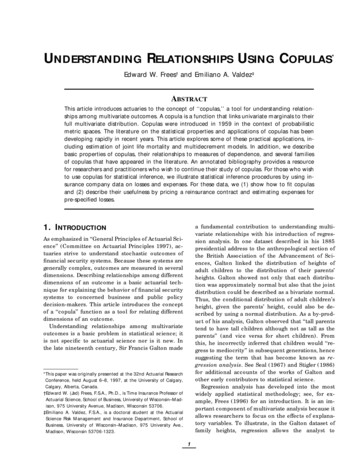
Transcription
UNDERSTANDING RELATIONSHIPS USING COPULAS*Edward W. Frees† and Emiliano A. Valdez‡ABSTRACTThis article introduces actuaries to the concept of ‘‘copulas,’’ a tool for understanding relationships among multivariate outcomes. A copula is a function that links univariate marginals to theirfull multivariate distribution. Copulas were introduced in 1959 in the context of probabilisticmetric spaces. The literature on the statistical properties and applications of copulas has beendeveloping rapidly in recent years. This article explores some of these practical applications, including estimation of joint life mortality and multidecrement models. In addition, we describebasic properties of copulas, their relationships to measures of dependence, and several familiesof copulas that have appeared in the literature. An annotated bibliography provides a resourcefor researchers and practitioners who wish to continue their study of copulas. For those who wishto use copulas for statistical inference, we illustrate statistical inference procedures by using insurance company data on losses and expenses. For these data, we (1) show how to fit copulasand (2) describe their usefulness by pricing a reinsurance contract and estimating expenses forpre-specified losses.1. INTRODUCTIONa fundamental contribution to understanding multivariate relationships with his introduction of regression analysis. In one dataset described in his 1885presidential address to the anthropological section ofthe British Association of the Advancement of Sciences, Galton linked the distribution of heights ofadult children to the distribution of their parents’heights. Galton showed not only that each distribution was approximately normal but also that the jointdistribution could be described as a bivariate normal.Thus, the conditional distribution of adult children’sheight, given the parents’ height, could also be described by using a normal distribution. As a by-product of his analysis, Galton observed that ‘‘tall parentstend to have tall children although not as tall as theparents’’ (and vice versa for short children). Fromthis, he incorrectly inferred that children would ‘‘regress to mediocrity’’ in subsequent generations, hencesuggesting the term that has become known as regression analysis. See Seal (1967) and Stigler (1986)for additional accounts of the works of Galton andother early contributors to statistical science.Regression analysis has developed into the mostwidely applied statistical methodology; see, for example, Frees (1996) for an introduction. It is an important component of multivariate analysis because itallows researchers to focus on the effects of explanatory variables. To illustrate, in the Galton dataset offamily heights, regression allows the analyst toAs emphasized in ‘‘General Principles of Actuarial Science’’ (Committee on Actuarial Principles 1997), actuaries strive to understand stochastic outcomes offinancial security systems. Because these systems aregenerally complex, outcomes are measured in severaldimensions. Describing relationships among differentdimensions of an outcome is a basic actuarial technique for explaining the behavior of financial securitysystems to concerned business and public policydecision-makers. This article introduces the conceptof a ‘‘copula’’ function as a tool for relating differentdimensions of an outcome.Understanding relationships among multivariateoutcomes is a basic problem in statistical science; itis not specific to actuarial science nor is it new. Inthe late nineteenth century, Sir Francis Galton made*This paper was originally presented at the 32nd Actuarial ResearchConference, held August 6–8, 1997, at the University of Calgary,Calgary, Alberta, Canada.†Edward W. (Jed) Frees, F.S.A., Ph.D., is Time Insurance Professor ofActuarial Science, School of Business, University of Wisconsin–Madison, 975 University Avenue, Madison, Wisconsin 53706.‡Emiliano A. Valdez, F.S.A., is a doctoral student at the ActuarialScience Risk Management and Insurance Department, School ofBusiness, University of Wisconsin–Madison, 975 University Ave.,Madison, Wisconsin 53706-1323.1
2describe the effect of parents’ height on a child’s adultheight. Regression analysis also is widely applied inactuarial science; as evidence, it is a required educational component of the two main actuarial bodiesin the U.S. and Canada, the Society of Actuaries andthe Casualty Actuarial Society.Although widely applicable, regression analysis islimited by the basic setup that requires the analyst toidentify one dimension of the outcome as the primarymeasure of interest (the dependent variable) andother dimensions as supporting or ‘‘explaining’’ thisvariable (the independent variables). This article examines problems in which this relationship is not ofprimary interest; hence, we focus on the more basicproblem of understanding the distribution of severaloutcomes, a multivariate distribution. For an example in actuarial science, when two lives are subject tofailure, such as under a joint life insurance or annuitypolicy, we are concerned with joint distribution oflifetimes. As another example, when we simulate thedistribution of a scenario that arises out of a financialsecurity system, we need to understand the distribution of several variables interacting simultaneously,not in isolation of one another.The normal distribution has long dominated thestudy of multivariate distributions. For example, leading references on multivariate analysis, such as Anderson (1958) and Johnson and Wichern (1988), focusexclusively on the multivariate normal and related distributions that can be derived from normal distributions, including multivariate extensions of Student’s tand Fisher’s F-distributions. Multivariate normal distributions are appealing because the marginal distributions are also normal. For example, in the Galtondataset, the distribution of adult children’s height andthe distribution of parents’ height are each approximately normal, in isolation of the other. Multivariatenormal distributions are also appealing because the association between any two random outcomes can befully described knowing only (1) the marginal distributions and (2) one additional parameter, the correlation coefficient.More recent texts on multivariate analysis, such asKrzanowski (1988), have begun to recognize theneed for examining alternatives to the normal distribution setup. This is certainly true for actuarial science applications such as for lifetime randomvariables (Bowers et al. 1997, Chap. 3) and longtailed claims variables (Hogg and Klugman 1984),where the normal distribution does not provide anadequate approximation to many datasets. An extensive literature in statistics deals with nonnormalNORTH AMERICAN ACTUARIAL JOURNAL, VOLUME 2, NUMBER 1multivariate distributions; see, for example, Johnsonand Kotz (1973) and Johnson, Kotz and Balakrishnan(1997). However, historically many multivariate distributions have been developed as immediate extensions of univariate distributions, examples being thebivariate Pareto, bivariate gamma, and so on. Thedrawbacks of these types of distributions are that (1)a different family is needed for each marginal distribution, (2) extensions to more than just the bivariatecase are not clear, and (3) measures of associationoften appear in the marginal distributions.A construction of multivariate distributions thatdoes not suffer from these drawbacks is based on thecopula function. To define a copula, begin as youmight in a simulation study by considering p uniform(on the unit interval) random variables, u1, u2, . . . ,up . Here, p is the number of outcomes that you wishto understand. Unlike many simulation applications,we do not assume that u1, u2 , . . . , up are independent; yet they may be related. This relationship is described through their joint distribution function !C u1, u2 , . . . , up !5 Prob U1 u1, U2 u2 , . . . , Up u p.Here, we call the function C a copula. Further, U isa (ex-ante) uniform random variable, whereas u is thecorresponding (ex-post) realization. To complete theconstruction, we select arbitrary marginal distribution functions F1 (x1), F2 (x2), . . . , Fp (xp). Then, thefunction@#C F1 x1!, F2 x2!, . . . , Fp xp! !5 F x1, x2 , . . . , xp(1.1)defines a multivariate distribution function, evaluatedat x1, x2, . . . , xp , with marginal distributions F1, F2,. . . , Fp .With copula construction in Equation (1.1), we select different marginals for each outcome. For example, suppose we are considering modeling male andfemale lifetimes for a joint-life annuity product. Then,with p52, we might choose the Gompertz distributionto represent mortality at the older ages, yet with different parameters to reflect gender differences inmortality. As another example, in Section 4, we consider a bivariate outcome associated with the loss andthe expense associated with administering a propertyand casualty claim. There, we could elect to use alognormal distribution for expenses and a longer taildistribution, such as Pareto, for losses associated with
UNDERSTANDING RELATIONSHIPS USING COPULASthe claim. The copula construction does not constrainthe choice of marginal distributions.In Section 2 we see that the copula method for understanding multivariate distributions has a relativelyshort history in the statistics literature; most of thestatistical applications have arisen in the last tenyears. However, copulas have been studied in theprobability literature for about 40 years (Schweizer1991), and thus several desirable properties of copulas are now widely known. To begin, it is easy tocheck from the construction in Equation (1.1) that Fis a multivariate distribution function. Sklar (1959)established the converse. He showed that any multivariate distribution function F can be written in theform of Equation (1.1), that is, using a copula representation. Sklar also showed that if the marginal distributions are continuous, then there is a uniquecopula representation. In this sense copulas providea unifying theme for our study of multivariate distributions. Sections 3 and 5 describe other desirableproperties of copulas.Given that copulas are fundamental building blocksfor studying multivariate distributions, we now turnto the question of how to build a copula function fora problem at hand. Despite Sklar’s result that a copulafunction always exists, Example 1.1 shows that it isnot always convenient to identify the copula. Example1.2 illustrates a useful way of building a copula, usingthe method of compounding. We describe this methodof constructing copulas in detail in Section 3.1.3 !Prob Xj xj 5 Fj xj! Basic calculations show that the joint distribution is1F x1, x2! 5 F1 x1! 1 F2 x2! 2 1 Suppose that we wish to model p52 lifetimes that wesuspect are subject to some common disaster, or‘‘shock,’’ that may induce a dependency between thelives. For simplicity, let us assume that Y1 and Y2 aretwo independent (underlying) lifetimes with distribution functions H1 and H2. We further assume thereexists an independent exponential random variable Zwith parameter l that represents the time until common disaster. Both lives are subject to the same disaster, so that actual ages-at-death are represented byX1 5 min(Y1, Z) and X2 5min(Y2, Z). Thus, the marginal distributions are1! ! !1 exp lmax x1 ,x2! 1 2 F1 x1! 1 2 F2 x2! .This expression, although intuitively appealing, is notin the form of the copula construction (1.1) becausethe joint distribution function F is not a function ofthe marginals F1(x1) and F2(x2). For further discussions in the actuarial literature of this bivariate distribution, see Frees (1996) and Bowers et al. (1997,Sec. 9.6).Example 1.2 Bivariate Pareto ModelConsider a claims random variable X that, given a riskclassification parameter g, can be modeled as an exponential distribution; that is,Prob X x g! 5 1 2 e2gx.As is well known in credibility theory (see, for example, Klugman et al. 1997), if g has a gamma distribution, then the marginal distribution (over all riskclasses) of X is Pareto. That is, if g is gamma(a,l), then !F(x) 5 Prob X x5Example 1.1 Marshall-Olkin (1967) ExponentialShock Model!5 1 2 exp 2lxj! 1 2 Hj xj! , for j 5 1, 2.* Prob X x g! Gal512l !*e2gxalG l!ga21 e2lg dgg a21 e 2lg dg5 1 2 1 1 x/l!2a,(1.2)a Pareto distribution.Suppose, conditional on the risk class g, that X1 andX2 are independent and identically distributed. Assuming that they come from the same risk class ginduces a dependency. The joint distribution is2F(x1,x2) 5 Prob(X1 x1, X2 x2) 5 1 2 Prob(X1 . x1) 2 Prob(X2 . x2) 1 Prob(X1 . x1, X2 . x2)5 1 2 exp(2lx1)(1 2 H1(x1)) 2 exp(2lx2)(1 2 H2(x2)) 1 exp(2lmin(x1, x2))(1 2 H1(x1))(1 2 H2(x2))5 1 2 (1 2 F1(x1)) 2 (1 2 F2(x2)) 1 exp(2l min(x1, x2)) exp(l(x1 1 x2))(1 2 F1(x1))(1 2 F2(x2)).
4NORTH AMERICAN ACTUARIAL JOURNAL, VOLUME 2, NUMBER 1F x1,x2! 5 F1 x1! 1 F2 x2!211@ 1 2 F x !! !3) a class of functions called ‘‘Archimedean copulas,’’which arise from the mathematical theory of associativity. An important special case of this class, due toFrank (1979), is21/a11 1 2 F2 x2!1#21/a212a.C u, v! 5This yields the copula functionC u1, u2! 5 u1 1 u2 2 11@ 1 2 u ! 21/a!1 1 2 u21#21/a2a21.(1.3)With this function, we can express the bivariate distribution function as H(x1, x2)5C(F1(x1), F2(x2)).Alternatively, we can consider the copulaC* u1, u2! 5 C 1 2 u1, 1 2 u2! 2a!5 u 21/a1 u 21/a211221and express the joint survival function as Prob(X1.x1,X2.x2) 5 C*(S1(x1), S2(x2)), where S512F. Becauseour motivating examples in Section 2 concern lifetime(positive) random variables, we often find it intuitivelyappealing to work with survival in lieu of distributionfunctions.Several methods are available for constructing multivariate distributions; see Hougaard (1987) andHutchinson and Lai (1990) for detailed reviews. Example 1.1 illustrates the so-called ‘‘variables-in-common’’ technique in which a common element serves toinduce dependencies among several random variables.This article focuses on the compounding method illustrated in Example 1.2 for two reasons. First, there is along history of using compound distributions for riskclassification in the actuarial science literature, particularly within the credibility framework. Second, Marshall and Olkin (1988) showed that compounding canbe used to generate several important families of copulas. Additional discussion of this point appears in Sections 2 and 3.Examples 1.1 and 1.2 each describe bivariate distributions through probabilistic interpretations of random quantities. It is also useful to explore (in Section2 x1l512 x1l512 x1l111111! x2l! x2l! x2l2a2112a2112a211!1* Prob(X!1*e2a2a12gx1! @2a111Copulas are useful for examining the dependencestructure of multivariate random vectors. In this section, we describe two biological science subject areasthat are related to actuarial science and that have usedcopulas to understand empirical relationships amongmultivariate observations.2.1 Survival of Multiple LivesIn epidemiological and actuarial studies, it is often ofinterest to examine the joint mortality pattern ofgroups of more than a single individual. This groupal a21 2lggedgG(l)#x1 1 x2l2a.(1.4)2. EMPIRICAL APPLICATIONS. x1 g) Prob(X2 . x2 g)e2gx2!Although Frank’s copula does not appear to have a natural probabilistic interpretation, its other desirableproperties make it well suited for empirical applications (Nelson 1986 and Genest 1987).The purpose of this paper is to introduce copulas,their characteristics and properties, and their applicability to specific situations. Section 2 reviews empirical applications of copulas in analyzing survival ofmultiple lives and competing risks. Both are familiartopics to actuaries. Section 3 discusses properties andcharacteristics of copulas. In particular, we show (1)how to specify a copula, (2) how the association structure of copulas can be summarized in terms of familiarmeasures of dependence, and (3) how simulation ofmultivariate outcomes can be easily accomplishedwhen the distribution is expressed as a copula. Section4 provides an illustration of fitting a copula to insurance company losses and expenses. Section 5 reviewsadditional applications of copulas. We conclude in Section 6.F(x1,x2) 5 1 2 Prob(X1 . x1) 2 Prob(X2 . x2) 1 Prob(X1 . x1, X2 . x2)512 1(e au 2 1)(e av 2 1)ln 1 1.aea 2 1al a21 2lggedgG(l)
UNDERSTANDING RELATIONSHIPS USING COPULAScould be, for example, a husband and wife, a familywith children, or twins (identical or nonidentical).There is strong empirical evidence that supports thedependence of mortality on pairs of individuals. Forexample, statistical analyses of mortality patterns ofmarried couples are frequently made to test the ‘‘broken heart’’ syndrome. Using a dataset consisting of4,486 55-year-old widowers, Parkes et al. (1969)showed that there is a 40% increase in mortality amongthe widowers during the first few months after thedeath of their wives; see also Ward (1976). Intuitively,pairs of individuals exhibit dependence in mortality because they share common risk factors. These factorsmay be purely genetic, as in the case of twins, or environmental, as in the case of a married couple.The first application of copulas in joint-life modelsarose indirectly through the work of Clayton (1978) inhis study of bivariate life tables of fathers and sons.Clayton developed the bivariate distribution functiongiven in Equation (1.3) as the solution of a secondorder partial differential equation. Clayton also pointedout the random effects interpretation of the model thatwas subsequently developed by Oakes (1982). See alsoCook and Johnson (1981).Random effects models are important in biologicaland epidemiological studies because they provide amethod of modeling heterogeneity. A random effectsmodel particularly suited for multivariate survival analysis is the frailty model, due to Vaupel, Manton andStallard (1979) and Hougaard (1984). To describefrailty models, we first introduce some notation. In survival analysis, it is customary to consider the complement of the distribution function, the survival function,and the negative derivative of its logarithmic transform, the hazard function. Thus, for a continuous random survival time T, we define5proportional in the sense that all the informationcontained in the explanatory variables is in the multiplicative factor g5ebZ. Integrating and exponentiating the negative hazard, we can also express Cox’sproportional hazard model as S(t g) 5 exp 2h(t, Z) 5 e bZ b(t),where b(t) is the so-called ‘‘baseline’’ hazard functionand b is a vector of regression parameters. It ish(s, Z)ds 5 B(t)g. *!tB(t) 5 exp 2b(s)ds0is the survival function corresponding to the baselinehazard. Frailty models arise when Z, and hence g, isunobserved. The factor g is called a frailty becauselarger values of g imply a smaller survival function,S(t g), indicating poorer survival. As demonstratedin Example 1.2, the marginal distribution for a singlelife T is obtained by taking expectations over the potential values of g; that is, S(t) 5 Eg S(t g).Oakes (1989, 1994) described how frailties can beused to model the dependencies among multiplelives. Other studies, such as Jagger and Sutton(1991), used a Cox regression model with known explanatory variables Z to account for the dependencies among multiple lives. Multivariate frailty modelsare obtained when the investigator does not wish toattribute, or does not have knowledge of, specificcharacteristics that may induce dependencies. Formultivariate frailty models, we assume that ‘‘p’’ livesT1, T2, . . . , Tp are independent given the frailty g.That is, Prob T1 . t1, . . . , Tp . tp g !! 5 Prob T1 . t1 g z z z Prob Tp . tp g!5 S1 t1 g! z z z Sp tp g!andActuaries know the hazard function h(t) as the forceof mortality (see, for example, Bowers et al. 1997,Chap. 3).To understand explanatory variables Z in survivalanalysis, we can use the Cox (1972) proportional hazards model, which represents the hazard function ast0Here,S(t) 5 Prob(T . t) 5 1 2 F(t)] ln S(t)f(t)h(t) 5 25.]tS(t)!*5 B1(t1)g z z z Bp tp!g .The joint multivariate survival function is defined as !Prob T1 . t1, . . . , Tp . tp g%5 Eg B1 t1! z z z Bp tp! .(2.1)Example 2.1 Hougaard’s Copula FamilyTo illustrate, an important frailty model was givenby Hougaard (1986), who assumed that the distribution of g could be modeled as a positive ‘‘stable distribution’’ with Laplace transform Ege2sg 5exp(2sa)
6NORTH AMERICAN ACTUARIAL JOURNAL, VOLUME 2, NUMBER 1and parameter a. Recall that the Laplace transform ofa positive random variable g is defined byt(s) 5 Eg e2sg 5*e2stdGg (t),where Gg is the distribution function of g. This is alsothe moment generating function evaluated at -s; thus,knowledge of t(s) determines the distribution.With a positive stable distribution for g, using Equation (2.1) we have !Prob T1 . t1, . . . , Tp . tp 2.2 Competing Risks—Multiple DecrementTheory%!5 Eg exp g ln B1 (t1) z z z Bp(tp) % !.a5 exp 2 2ln B1(t1) – z z z – ln Bp(tp)Because % !,Si(ti) 5 exp 2 2ln Bi(ti)awe can write the joint survival function as !Prob T1 . t1, . . . , Tp . tp @ %5 exp 2 2 ln S1(t1)1/a% # !, 1 z z z 1 2 ln Sp(tp)1/aa(2.2)a copula expression. In particular, for bivariate lifetimes with p52, Hougaard proposed examining Weibull marginals so that Bi(t)5exp 2aitb ! and Si(t g)5exp 2aigtb !. This yields the bivariate survivor functionii !Prob T1 . t1, T2 . t2 @# !.5 exp 2 a1 t 1b1 1 a2 t 2b2abetween 1881 and 1930. They use the frailty modelarising from a positive stable distribution as well asCox’s proportional hazard model. Frees et al. (1995)investigated mortality of annuitants in joint- and lastsurvivor annuity contracts using Frank’s copula(Equation 1.3). They found that accounting for dependency in mortality produced approximately a 3% to 5%reduction in annuity values when compared to standard models that assume independence.(2.3)This is desirable in the sense that both the conditionaland marginal distributions are Weibull.Equations (1.2) of Example 1.2 and (2.2) of Example2.1 show that these frailty models can be written ascopulas. Marshall and Olkin (1988) showed that theseare special cases of a more general result; they demonstrated that all frailty models of the form in Equation(2.1) can be easily written as copulas. Further, the copula form is a special type called an Archimedean copula, which we will introduce in Section 3.In addition to the Clayton and Oakes studies, otherworks have investigated the use of copula models instudying behavior of multiple lives. Hougaard et al.(1992) analyzed the joint survival of Danish twins bornThe subject of competing risks deals with the study ofthe lifetime distribution of a system subject to severalcompeting causes; this subject is called multiple decrement theory in actuarial science (see, for example,Bowers et al. 1997, Chap. 10 and 11). The problem ofcompeting risks arises in survival analysis, systems reliability, and medical studies as well as in actuarial science. For example, a person dies because of one ofseveral possible causes: cancer, heart disease, accident, and so on. As yet another example, a mechanicaldevice fails because a component fails. For mathematical convenience, the general framework begins withan unobserved multivariate lifetime vector (T1, T2, . . . ,Tp); each element in the vector denotes the lifetimedue to one of p competing causes. The quantities typically observed are T5min(T1, T2, . . . , Tp) and thecause of failure J. To illustrate, in life insurance, Tusually denotes the lifetime of the insured individualand J denotes the cause of death such as cancer oraccidental death. Several texts lay the foundation ofthe theory of competing risks. For example, see Bowers et al. (1997), Cox and Oakes (1984), David andMoeschberger (1978), and Elandt-Johnson and Johnson (1980).When formulating the competing risk model, it isoften assumed that the component lifetimes Ti arestatistically independent. With independence, themodel is easily tractable and avoids the problem ofidentifiability encountered in inference. However,many authors, practitioners, and academicians recognize that this assumption is not practical, realistic,or reasonable; see Carriere (1994), Makeham (1874),and Seal (1977).To account for dependence in competing risk models, one general approach is to apply copulas. In particular, the frailty model seems well suited for handlingcompeting risks. Assuming that causes of death are independent given a frailty g, we have
UNDERSTANDING RELATIONSHIPS USING COPULAS7 3. PROPERTIES!Prob T . t g! 5 Prob min T1, . . . , Tp! . t5 Prob T1 . t g! z z z Prob Tp . t g!5 B1(t)g z z z Bp(t)g .Thus, similar to Equation (2.1), the overall survivalfunction isg %Prob T . t! 5 Eg B1(t) z z z Bp(t) .(2.4)Example 2.1 (Continued)For a positive stable distribution for g, the survivalfunction is @ 2 ln S (t)%1 z z z 1 2 ln S (t)% # ! ,1/aProb T . t! 5 exp 211/aapsimilar to Equation (2.2). For bivariate lifetimes withWeibull marginals, we have Prob T . t! 5 exp 2@a1 t b1 1 a2 t b2#!.aThere have been several applications of frailty models for studying competing risk situations. Oakes(1989) discussed the number of cycles of two chemotherapy regimes tolerated by 109 cancer patients.Shih and Louis (1995) analyzed HIV-infected patientsby using Clayton’s family, positive stable frailties, aswell as Frank’s copula. Zheng and Klein (1995) considered data from a clinical trial of patients with nonHodgkin’s lymphoma using gamma copula (as inClayton’s family). In a nonbiological context, Hougaard (1987) described how dependent competingrisk models using positive stable copulas can be usedto assess machine failure.COPULASOFThis section discusses several properties and characteristics of copulas, specifically (1) how to generatecopulas, (2) how copulas can summarize associationbetween random variables, and (3) how to simulatecopula distributions.3.1 Specifying Copulas: Archimedean andCompounding ApproachesCopulas provide a general structure for modeling multivariate distributions. The two main methods forspecifying a family of copulas are the Archimedeanapproach and the compounding approach, the latterillustrated in Example 1.2.The Archimedean representation allows us to reduce the study of a multivariate copula to a singleunivariate function. For simplicity, we first considerbivariate copulas so that p52. Assume that f is a convex, decreasing function with domain (0, 1] and range[0, ) such that f(1)50. Use f21 for the inverse function of f. Then the functionCf (u,v) 5 f 21 f(u) 1 f(v)! for u, v [ (0, 1]is said to be an Archimedean copula. We call f a generator of the copula Cf. Genest and McKay (1986a,1986b) give proofs of several basic properties of Cf,including the fact that it is a distribution function. Asseen in Table 1, different choices of generator yieldseveral important families of copulas. A generatoruniquely determines (up to a scalar multiple) an Archimedean copula. Thus, this representation helpsidentify the copula form. This point is further developed in Section 3.2.Examples 1.2 and 2.1 show that compound distributions can be used to generate copulas of interest.TABLE 1ARCHIMEDEAN COPULAS AND THEIR GENERATORSGenerator f(t)DependenceParameter (a) SpaceIndependence2 ln tNot applicableuvClayton (1978), Cook-Johnson (1981),Oakes (1982)t 2a 2 1a.1 uGumbel (1960), Hougaard (1986) 2 ln t!FamilyFrank (1979)alne at 2 1ea 2 1a 12 ,a, Bivariate Copula Cf(u,v)2aexp!1 v 2a 2 121/a 2 @ 2 ln u! 1 2 ln v! # %a a!1(e au 2 1)(e av 2 1)ln 1 1aea 2 11/a
8NORTH AMERICAN ACTUARIAL JOURNAL, VOLUME 2, NUMBER 1These examples are special cases of a general methodfor constructing copulas due to Marshall and Olkin(1988). To describe this method, suppose that Xi is arandom variable whose conditional, given a positivelatent variable gi, distribution function is specified byHi(x gi) 5Hi(x)g , where Hi(z) is some baseline distribution function, for i51, . . . , p. Marshall and Olkinconsidered multivariate distribution functions of theformi !F(x1, x2, . . . , xp) 5 EK H1(x1) g1, . . . , Hp(xp) gp .Here, K is a distribution function with uniform marginals and the expectation is over g1, g2, . . . , gp. Asa special case, take all latent variables equal to oneanother so that g1 5g2 5. . .5 gp 5 g and use the distribution function corresponding to independent marginals. Marshall and Olkin (1988) showed thatF x1, x2, . . . , xp) 5 t t F (x )% 1!5 Eg H1(x1)g z z z Hp(xp)g2111%! z z z 1 t21 Fp(xp)(3.2)where Fi is the i-th marginal distribution of F and t(z)is the Laplace transform of g, defined by t(s)5Eg e 2sg.Laplace transforms have well-defined inverses. Thus,from Equation (3.2), we see that the inverse functiont 21 serves as the generator for an Archimedean copula.In this sense, Equation (3.2) provides a probabilisticinterpretation of generators. To illustrate, Table 2 provides the inverse Laplace transform for the generatorslisted in Table 1. Here, we see how well-known distributions can be used to generate compound distributions. Because generators are defined uniquely only upto scalar multiple, any positive constant in the familyof Laplace transforms determines the same class ofgenerators. (Indeed, this methodology suggests newcopula families.) Thus, the inverse of a Laplace transform represents an important type of generator forArchimedean copulas.To summarize, assume that X1, X2, . . . , Xp are conditionally, given g, independent with distributionfunctions Hi(x)g. Then, the multivariate distributionis given by the copula form with the generator beingthe inverse of the Laplace transform of the latent variable g. Because of the form of the conditional distribution, we follow Joe (1997) and call this a mixtureof powers distribution. We remark thatt @2 ln Hi (x)# 5 Eg exp 2@2 ln Hi (x)# g% 5 Fi (x)so thatHi (x) 5 exp 2 t21 @Fi
1 UNDERSTANDING RELATIONSHIPS USING COPULAS* Edward W. Frees† and Emiliano A. Valdez‡ ABSTRACT This article introduces actuaries to the concept of ''copulas,'' a tool for understanding relation-ships among multivariate outcomes.
